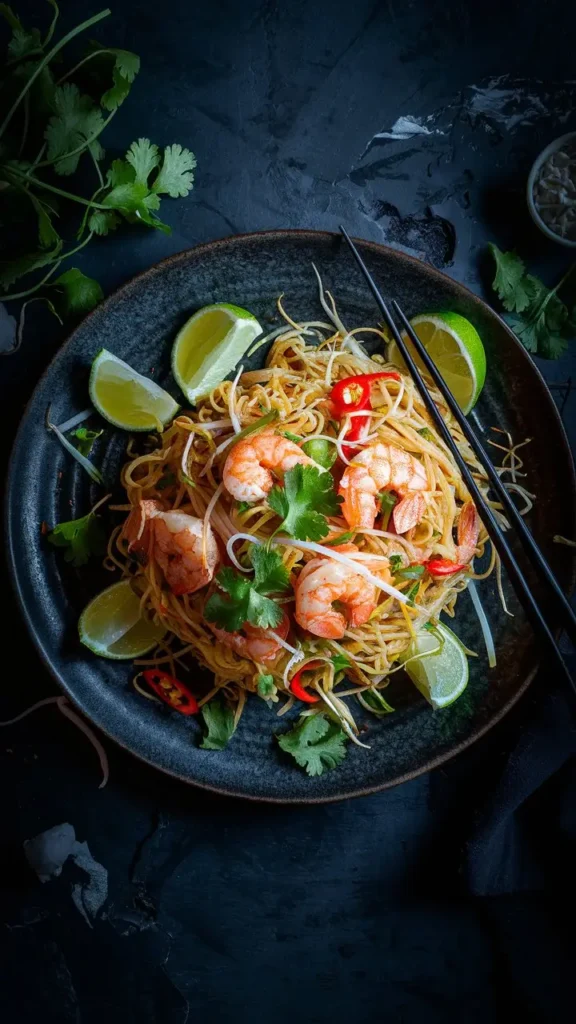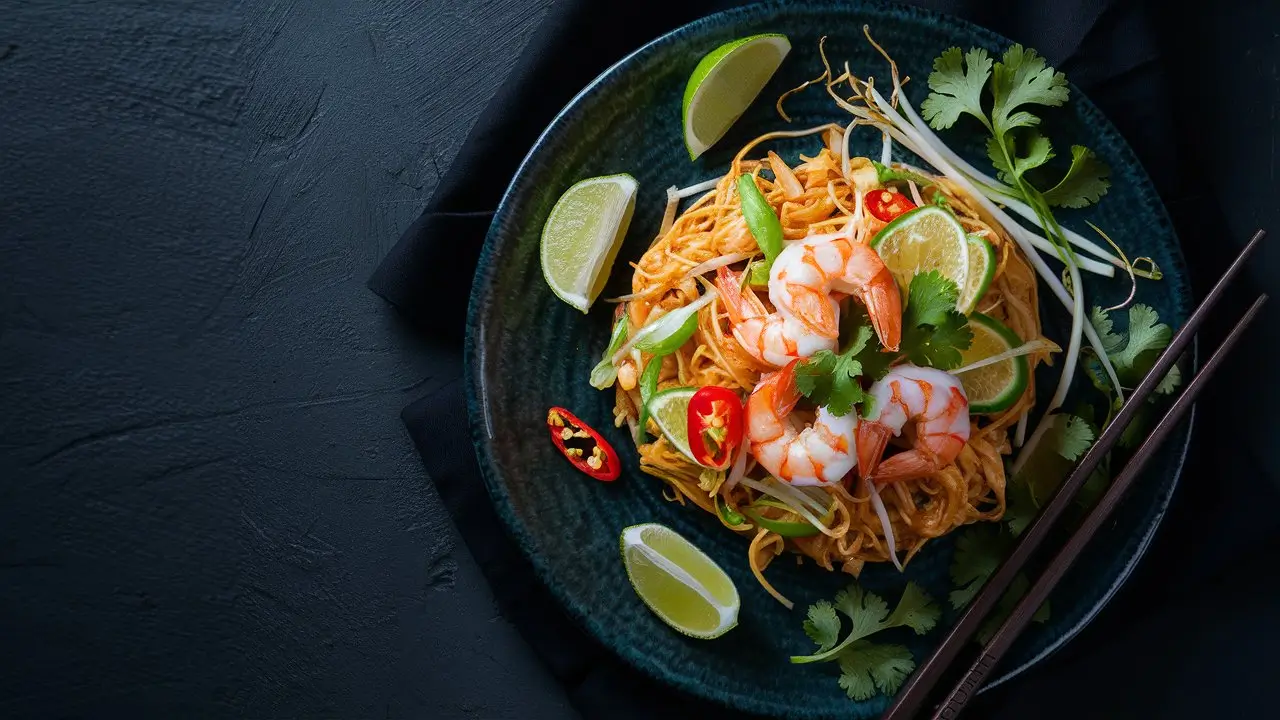If you’ve ever tasted Pad Thai at a Thai restaurant or a street food stall, you know how unforgettable it is—chewy rice noodles, sweet-savory sauce, crunchy peanuts, tender meat or tofu, and a pop of lime all come together in one flavorful bite. Pad Thai is more than just a noodle dish—it’s a vibrant, balanced masterpiece of Thai cuisine.
Why You’ll Love This Pad Thai Recipe
-
Restaurant-quality at home – Taste just like your favorite Thai spot.
-
Quick cooking time – The dish comes together in under 30 minutes.
-
Customizable – Use chicken, shrimp, tofu, or make it vegetarian.
-
Balanced flavor profile – Sweet, salty, sour, and umami all in one.
-
Great for meal prep – Easily reheats and still tastes amazing.
What Is Pad Thai?
Pad Thai is Thailand’s national dish and a staple of Thai street food. It’s made with stir-fried rice noodles, tamarind-based sauce, scrambled egg, protein like shrimp or tofu, and topped with peanuts, bean sprouts, and lime. It’s all about balance—sweet from palm sugar, sour from tamarind, salty from fish sauce, and heat from optional chili flakes.
Ingredients List
For the Sauce:
-
3 tablespoons tamarind paste (unsweetened)
-
3 tablespoons fish sauce (or soy sauce for vegan)
-
2 tablespoons palm sugar (or brown sugar)
-
1 tablespoon rice vinegar
-
½ teaspoon chili flakes (optional)
For the Stir-Fry:
-
200g (7 oz) dried flat rice noodles (3–5 mm wide)
-
2 tablespoons oil (peanut or vegetable)
-
2 cloves garlic, minced
-
2 eggs
-
1 cup bean sprouts
-
½ cup green onions or garlic chives, chopped
-
½ cup crushed roasted peanuts
-
1 lime, cut into wedges
Protein Options (Choose One):
-
200g chicken breast, thinly sliced
-
200g shrimp, peeled and deveined
-
200g tofu, cubed and fried
Timing and Servings
-
Prep Time: 20 minutes
-
Cook Time: 10 minutes
-
Total Time: 30 minutes
-
Servings: 2–3
How to Make Pad Thai: Step-by-Step Guide
Step 1: Soak the Noodles
Place the dried rice noodles in a large bowl and cover with warm water. Soak for about 20–30 minutes until they are pliable but not mushy. Drain and set aside.
Step 2: Make the Sauce
In a small bowl, combine tamarind paste, fish sauce, palm sugar, rice vinegar, and chili flakes. Stir until the sugar dissolves. Taste and adjust—more sugar for sweetness, more tamarind for tang.
Step 3: Cook the Protein
Heat a wok or large skillet over medium-high heat with 1 tablespoon oil. Add your chosen protein and cook until done. Remove from the pan and set aside.
Step 4: Scramble the Eggs
Add a little more oil if needed. Crack in the eggs and scramble them quickly until just set.
Step 5: Stir-Fry the Noodles
Add the soaked noodles to the pan with the eggs. Pour the sauce over the noodles. Stir and toss everything quickly to coat evenly.
Step 6: Add Protein and Vegetables
Return your cooked protein to the pan. Add bean sprouts and half the green onions. Stir-fry everything together for 1–2 more minutes.
Step 7: Serve and Garnish
Plate the Pad Thai and top with crushed peanuts, remaining green onions, and fresh lime wedges. Serve hot with extra bean sprouts and chili flakes on the side.

Tips for Perfect Pad Thai
1. Use the Right Noodles
Flat rice noodles work best—look for Thai brands for the most authentic texture.
2. Don’t Overcook the Noodles
Soak until pliable, not mushy. Overcooked noodles will break or become sticky.
3. Cook Quickly
High heat and fast movement are key to good stir-fry texture.
4. Balance the Sauce
Adjust tamarind, sugar, and fish sauce until the flavor hits that sweet-savory-sour balance.
5. Use a Wok If Possible
The high heat and curved surface of a wok give the best results. A large nonstick skillet works too.
Variations of Pad Thai to Try
1. Vegan Pad Thai
Use tofu as your protein, and replace fish sauce with soy sauce or vegan fish sauce.
2. Chicken Pad Thai
Use thinly sliced chicken breast or thigh for a meaty and tender option.
3. Shrimp Pad Thai
Classic and quick—shrimp cooks in just a few minutes.
4. Spicy Pad Thai
Add extra chili paste or Sriracha for more heat.
5. Pad Thai with Peanuts and Lime
Increase the crunch and brightness with extra crushed peanuts and lots of lime juice.
Ingredient Substitutions
Traditional Ingredient Substitute Tamarind paste Lime juice + a little brown sugar Fish sauce Soy sauce or tamari Palm sugar Brown sugar or coconut sugar Rice noodles Glass noodles or even linguine (not authentic, but works in a pinch)
Make-Ahead Tips for Pad Thai
-
Prep noodles, sauce, and proteins ahead – Store separately until ready to cook.
-
Cook only what you’ll eat – Pad Thai is best fresh, but you can reheat leftovers gently in a pan.
Storage and Reheating
-
Refrigerator – Store leftovers in an airtight container for up to 3 days.
-
Reheating – Use a skillet or wok with a splash of water or oil. Avoid microwaving if possible—it makes the noodles rubbery.
Serving Ideas and Pairings
-
Side Dishes: Thai cucumber salad, spring rolls, or tom yum soup
-
Drinks: Thai iced tea, jasmine tea, or a citrusy mocktail
-
Condiments: Extra lime wedges, chili powder, or pickled radish for added flavor
Health Benefits of Pad Thai
While traditional Pad Thai isn’t necessarily low in calories, it can be a balanced meal when homemade:
-
Protein-rich – Choose shrimp, tofu, or lean chicken.
-
Vegetable-filled – Bean sprouts, garlic chives, and even bell peppers can be added.
-
No MSG or preservatives – Control what goes into your food when cooking from scratch.
-
Customizable – Easily adapted to gluten-free or low-carb diets.
Common Mistakes to Avoid
-
Overcooking the noodles – Always undercook slightly as they’ll continue cooking in the pan.
-
Skipping the sauce balance – Pad Thai sauce must be balanced to taste great.
-
Using the wrong pan – A small or low-heat pan won’t stir-fry properly.
-
Overloading the pan – Cook in batches if necessary to avoid steaming instead of frying.
FAQs
Q1: What is the main flavor of Pad Thai?
Pad Thai has a sweet, sour, and savory flavor profile balanced with a hint of tang from tamarind.
Q2: Can I use lemon juice instead of tamarind?
Lemon juice is too sharp on its own. If you can’t find tamarind, use a mix of lime juice and brown sugar.
Q3: Is Pad Thai gluten-free?
Not always. Use gluten-free tamari instead of soy or fish sauce, and verify that your noodles are 100% rice-based.
Q4: Can I make Pad Thai without peanuts?
Yes. Simply leave them out or replace them with cashews or sunflower seeds.
Q5: Can I freeze Pad Thai?
It’s not recommended. Rice noodles get mushy and lose texture when frozen and reheated.
Conclusion
Pad Thai is more than just a takeout favorite—it’s a cultural dish packed with flavor, color, and history. Making it at home is easier than you think and incredibly satisfying. With the right ingredients, a good sauce, and a hot wok, you can whip up a delicious Pad Thai that rivals any restaurant version.
Try this recipe and enjoy the sweet-sour-savory magic in every bite. Once you’ve mastered it, you’ll find endless ways to make Pad Thai your own—with different proteins, extra veggies, or added heat. It’s a dish that’s meant to be shared, savored, and made again and again.
